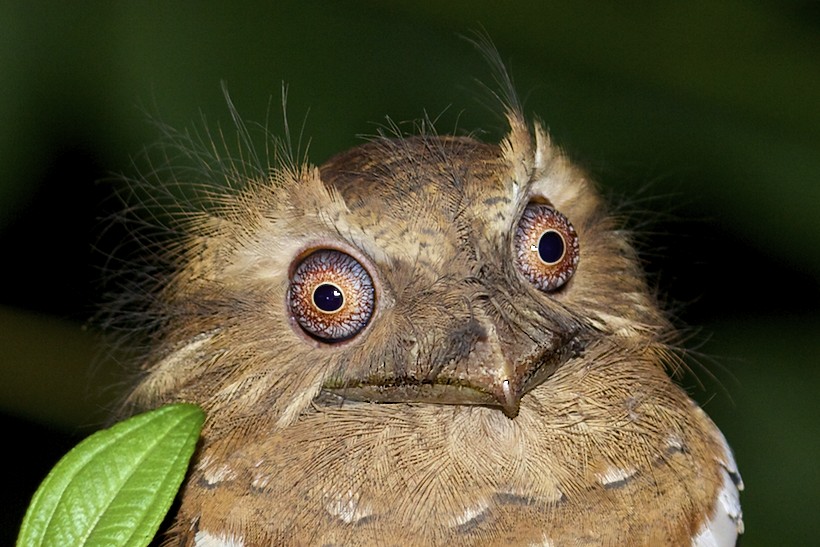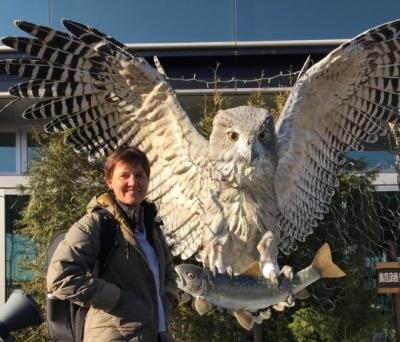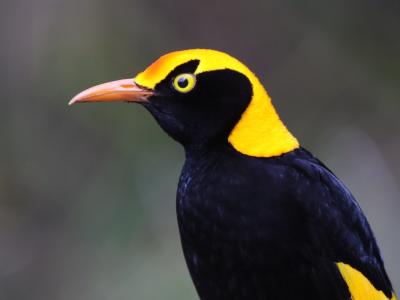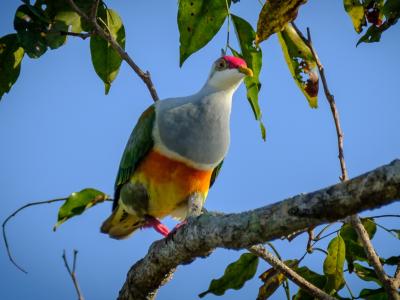Philippines
-
Jan 22 to Feb 6 2025
Susan Myers
Mindanao Extension to Feb 14 -
Jan 25 to Feb 9 2026
Susan Myers
2026 Tour Price to be Determined
2026 Tour Price to be Determined
Wedged between China, Japan, Malaysia, and Indonesia, the 7,000-plus islands of the Philippines have experienced successive invasions from different biogeographic zones that have fueled a spectacular adaptive radiation of species. Of the almost 600-bird species, an extraordinary 170 or more are endemic, and—with names such as Guaiabero, Scale-feathered Malkoha, Whiskered Pitta, Blue Fantail, and Coleto—the birds of the Philippines are without doubt some of the most fascinating in the world. Our tour provides an opportunity to explore the most important birding areas of this vast archipelago. We’ll visit the islands of Luzon, Bohol, and Negros, where we’ll search lowland and montane habitats for the special birds each island has to offer. We’ll also explore the island of Palawan with its stunning beach scenery, treasure trove of endemic birds, and an avifauna that has more in common with Borneo than with the rest of the Philippines.
Day 1: The tour begins this evening in Manila. Night in Manila.
Day 2: We’ll fly to Puerto Princesa on the island of Palawan. Before setting off to St. Paul’s National Park, we’ll visit nearby coastal areas for shorebirds and other waterbirds, including the rare Chinese Egret. Later in the morning we’ll drive to the delightful coastal town of Sabang near the World Heritage site, St. Paul’s National Park. Along the last 20 miles of our drive we have a good chance for birds such as Ruddy Kingfisher, Great Slaty Woodpecker, Palawan Tit, and Blue Paradise-Flycatcher, so we’ll take our time, stopping at a lookout to try for highly endangered Philippine Cockatoo, arriving in Sabang in the late afternoon. Night in Sabang.
Day 3: We’ll spend the day in St. Paul’s National Park and other areas surrounding Sabang. The park is beautifully located between high limestone cliffs and white sandy beaches and is covered in pristine forest. It’s the home of the Underground River, and in the early morning we’ll take a boat directly there to the best birding site. Later in the morning we’ll board our boat again and return to Sabang. The area is rich in birds, and there is a good chance of seeing a majority of the endemics and specialties, including Tabon Scrubfowl, Blue-naped Parrot, Palawan Swiftlet, Palawan Hornbill, Hooded Pitta, Yellow-throated Leafbird, Sulphur-bellied Bulbul, Ashy-headed Babbler, Falcated Ground-Babbler, White-vented Shama, Palawan Blue Flycatcher, Lovely Sunbird, and Palawan Flowerpecker. In the afternoon we’ll go to another site in search of many of these species as well as Palawan Scops-Owl and Javan Frogmouth then make our way back to Puerto Princesa. Night in Puerto Princesa.
Day 4: We’ll visit the Iwahig penal colony this morning - this is the best place to find the endemic Blue-headed Racquet-tail, as well as Melodious Babbler and Palawan Flycatcher. We’ll also explore the nearby rice paddies and fishponds for wetland birds. In the evening we’ll take a pleasant 30-minute boat trip to an offshore island in search of the very range-restricted Mantanani Scops-Owl (if permission is granted). Night in Puerto Princesa.
Day 5: We’ll catch an early morning flight back to Manila and upon arrival depart early for the Candaba Marshes before proceeding to Subic Bay, where we’ll bird the old United States Naval Magazine at Subic Bay and the adjacent forests.
The Candaba Marshes are surrounded by rice fields that come alive with birdsong in the early morning. We’ll find elegant Oriental Pratincoles coursing over the fields, as well as Eastern Marsh Harrier, Barred Rail, Asian Palm-Swift, Pied Bushchat, Zitting Cisticola, and Tawny Grassbirds. Around the marsh itself we should find Philippine Swamphen, Yellow Bittern, White-browed Crake, Black-winged Stilt, Whiskered Tern, and Pheasant-tailed Jacana, as well as large numbers of Purple and Black-crowned Night Herons. Ducks are often present in big numbers—especially Garganey, Eurasian Wigeon, and Northern Pintail—as well as lesser numbers of the endemic Philippine Duck.
Our initial afternoon birding foray at Subic Bay will be along a quiet and narrow forest road, and we can expect to see endemics such as White-eared Brown-Dove, Red-crested Malkoha, Black-and-white Triller, Philippine Pygmy Woodpecker, Coleto, and many others. Night in Subic Bay.
Day 6: We’ll spend all morning and the afternoon birding in Subic’s forests along the Nabasan road, and other areas. Specialty birds could include White-fronted Tit (increasingly difficult but we’ll try!), White-lored Oriole, Sooty Woodpecker, and Blackish Cuckoo-Shrike, and many other endemics can be found here as well. Night in Subic Bay.
Day 7: We’ll travel from Subic Bay to Infanta. In a lightly used stretch of Marilaque Highway in the Infanta area of Quezon, we should find several uncommon endemics, as well as delightful and relatively easy roadside birding in superb forest. We’ll hope to find Rufous Hornbill, Great-eared Nightjar, Olive-backed Flowerpecker, Yellow-breasted Fruit Dove, Philippine Trogon, and Philippine Fairy Bluebird among others. Most exciting of all, we’ll have a good chance of seeing the uncommon and glorious endemic, Flame-breasted Fruit Dove. Night in Infanta.
Day 8: We’ll bird along the Marilaque Highway looking for specialties in this verdant woodland such as Luzon Sunbird, Yellow-wattled Bulbul, Philippine Cuckoo-Dove, Amethyst Brown-Dove, Crested Honey Buzzard, and so much more. There will also be a good chance of finding the scarce endemic Whiskered Pitta, and we’ll enter the forest to make a special effort to see this attractive ground-dweller. Night in Infanta.
Day 9 & 10: We’ll begin with a short drive to Mount Makiling with its great selection of Luzon birds, including more than 50 endemics. Mount Makiling is a forested area on the slopes of an extinct volcano that is managed by University of the Philippines. It hosts a remarkable number of Philippine bird species and 2,000 flowering plants have been recorded here! Our birding will be mostly along the road, but we’ll take side trails for a change of terrain and a chance to see some of the ground species. Birds we’ll look include Philippine Serpent-Eagle, Luzon Bleeding-heart (very difficult), Black-chinned Fruit-Dove, Guaiabero, Philippine Hawk-Cuckoo, Luzon Hornbill, Scale-feathered Malkoha, Spotted Wood Kingfisher, Sulphur-billed Nuthatch, Striped-headed Rhabdornis, Gray-backed Tailorbird, Yellow-bellied Whistler, Lovely Sunbirds, and Striped Flowerpecker. Nights in Makiling.
Day 11: We’ll fly this morning from Manila to Tagbilaran on the island of Bohol where we’ll be met by our driver, who will take us straight to the Rajah Sikatuna National Park for late afternoon birding. Rajah Sikatuna was named after the Bohol chieftain who entered into a dubious contract with a Spanish conquistador by the name of Miguel López de Legazpi in 1565. The reserve is the largest remaining tract of natural forest in Bohol and is one of the Philippines’s top birdwatching sites. It is characterised by rolling hills with remnants of natural forest on limestone terrain, as well as by grasslands and natural springs, and is home to over 120 bird species. Two amazing mammals in the form of Philippines Tarsier, a diminutive primate, and Philippines Colugo, a unique creature sometimes erroneously called a flying lemur, also inhabit the protected landscape area. Night in Bilar.
Day 12: We’ll depart early to return to Rajah Sikatuna, where we’ll spend the day. Our target birds will be Steere’s Pitta, Visayan Broadbill, Black-crowned Babbler, and Yellow-breasted Tailorbird. Others we’ll look for include Rufous-lored Kingfisher, Streaked Ground-Babbler, Black-faced Coucal, Blue Fantail, Rufous-tailed Jungle Flycatcher, and Philippine Leaf Warbler. Mindanao Bleeding-heart is a very rare resident, but we might have a chance. Either in the early morning or the evening, we’ll search for nightbirds such as Philippine Hawk Owl, Philippine Frogmouth, and Philippine Nightjar. Night at Bilar.
Day 13 & 14: We’ll take a morning fast ferry to Dumaguete City this morning where we’ll have the next two days to explore the island of Negros where we hope to pick up many of the island’s endemics.
Day 15: We’ll spend some time birding in the morning and then return to Dumaguete City to catch our flight back to Manila.
Day 16: The main tour concludes this morning in Manila.
Mindanao Extension
Day 16: We’ll leave Manila for our flights to Cagayan de Oro, in North Mindanao. We’ll then have a long drive—four to five hours—to the small village of Damitan, where our guides and horses for luggage will meet us. We’ll have to walk from here to our lodge. The walk is moderately strenuous and takes around 2-3, or longer if we stop for birding. The lodge has a large open room upstairs for dormitory-style sleeping. All bedding is provided, and large tents are also available. There are basic bathing and Western-style toilet facilities. A delightful local family who cooks and caters will look after us very well. We should have time for some afternoon birding after we arrive. Night on Mount Kitanglad.
Days 17 - 18: We’ll have two full days birding in search of the Great Philippine Eagle and 20 or so Mindanao montane endemics. Birding here involves a daily walk uphill on narrow but well-worn trails; much of the area is open and under cultivation. The camp is situated at around 4400 feet, and on at least on one day we’ll walk up a little higher in search of such birds as MacGregor’s Cuckooshrike and Apo Mynah. Our target bird will be the Great Philippine Eagle, which we have a good chance of finding. Other birds—all endemics—include Bukidnon Woodcock, Giant Scops-Owl, Philippine Frogmouth, Philippine Swiftlet, Yellow-breasted Fruit-Dove, Mindanao Racquet-tail, Philippine Hanging-Parrot, Philippine Nightjar, Blue-capped Kingfisher, McGregor’s Cuckoo-Shrike, Stripe-breasted Rhabdornis, Bagobo Babbler, Rufous-headed Tailorbird, Long-tailed Ground-Warbler, Black-and-Cinnamon Fantail, Mountain Shrike, Gray-hooded Sunbird, Olive-capped, Flame-crowned, and Buzzing Flowerpeckers, Black-masked White-eye, Cinnamon Ibon, Red-eared Parrotfinch, and White-cheeked Bullfinch. Nights on Mount Kitanglad.
Day 19: We plan to depart camp after breakfast this morning and return to Damitan, where vans will be waiting to take us on our long drive across Mindanao to Bislig and on to PICOP, a large logging concession where we’ll spend three days birding. Although the forest is disappearing, it’s still rich in birds. Upon arrival, we’ll be met by our local guide Zardo, and in the afternoon we’ll visit the nearby airport (dependent on arrival time), where many wetland birds can be found, including Philippine Mallard, Wandering Whistling-Duck, Philippine Swamphen, Watercock, Black Bittern, and Australasian Grass-Owl. We’ll stay in a small but comfortable and friendly hotel. Night in Bislig.
Days 20 - 22: We’ll have two days to bird the vast PICOP logging concession, which has many different sites. We’ll be traveling around in a jeepney, which is able to navigate the rough roads. It will probably take 40 to 90 minutes to get to the birding sites in the morning, and the vehicles will stay with us all day. Among the many fabulous birds that we hope to see are Philippine Hawk-Eagle, Barred Honey-buzzard, Amethyst Brown-Dove, Black-chinned Fruit-Dove, Pink-bellied and Spotted Imperial-Pigeons, Blue-crowned Racquet-tail, Blue-backed Parrot, Black-faced Coucal, Philippine Drongo-Cuckoo, Philippine Needletail, Silvery and Rufous-lored Kingfishers, Rufous, Mindanao, and Writhed Hornbills, Sooty Woodpecker, Mindanao Wattled Broadbill, Steere’s and Red-bellied Pitas, Black-bibbed Cuckoo-Shrike, Philippine Leafbird, Philippine Bluebird, Yellowish and Yellow-wattled Bulbuls, Philippine Oriole, Streaked Ground-Babbler, Pygmy and Rusty-crowned Babblers, Brown Tit-Babbler, Philippine Leaf-Warbler, Black-headed and Rufous-fronted Tailorbirds, Rufous-tailed Jungle-Flycatcher, Rufous Paradise-Flycatcher, Little Slaty-Flycatcher, Blue Fantail, Celestial (difficult) and Short-crested Monarchs, Lovely Sunbird, Naked-faced Spiderhunter, and Olive-backed Flowerpecker. There are several interesting nightbirds in the area, including Chocolate and Mindanao Hawk-Owls. Nights in Bislig.
Day 23: This morning we’ll bird at Bislig before traveling 4-5 hours to Davao for our flight to Manila. Night in Manila.
Day 24: The Mindanao extension concludes this morning in Manila.
Note:The information presented here is an abbreviated version of our formal General Information for Tours to the Philippines. Its purpose is solely to give readers a sense of what might be involved if they take this tour. Although we do our best to make sure that what follows here is completely accurate, it should not be used as a replacement for the formal document which will be sent to all tour registrants, and whose contents supersedes any information contained here.
ENTERING THE PHILIPPINES : A passport valid for at least six months beyond your planned departure is required for United States citizens to enter the Philippines. Citizens of other countries should check with their consulate/embassy for instructions. If required by the embassy or visa-granting entity, WINGS can provide a letter for you to use regarding your participation in the tour.
COUNTRY INFORMATION: You can review the U.S. Department of State Country Specific Travel Information here: https://travel.state.gov/content/travel.html and the CIA World Factbook here: https://www.cia.gov/the-world-factbook/. Review foreign travel advice from the UK government here: https://www.gov.uk/foreign-travel-advice and travel advice and advisories from the Government of Canada here: https://travel.gc.ca/travelling/advisories.
CLIMATE: The Philippines is hot and humid year-round. The weather pattern across the archipelago is complex, but can be roughly divided into the dry season (September to May) and the wet season (June to September). There is little seasonal variation in most places with average highs and lows of around 31°C (87°F) and 24°C (76°F) respectively. Between December and May, slightly cooler and drier conditions prevail. At Mount Kitanglad the daytime temperature ranges from about 70°F (mid-day) (mid-50s at night); while in the lowlands it reaches about 90°F. Night time temperatures will be correspondingly higher, as well. The humidity is quite high which may make it seem hotter. Rainfall can be expected at any time in brief, heavy downpours. Total annual rainfall averages between 200 and 260 cm (between 77 and 100 inches), and falls mostly from October to February.
HEALTH: Unless advised otherwise, all water including tap water is NOT potable, bottled water will be provided throughout the tour. In many cases however you can safely enjoy the salads, fresh fruit and vegetables. Your leader will advise. No vaccinations are required, however, cholera and yellow fever inoculations are required if you arrive within five days of departing from an infected area. Typhoid vaccination is particularly important because of the presence of S. typhi strains resistant to multiple antibiotics in this region. There is no risk for yellow fever in the Philippines. Malaria is present and participants are strongly advised to take and seek the advice of their doctor with regard to the form of prophylactic to use. As standard travel precautions, you should always be up to date with tetanus shots, and strongly consider inoculations against Hepatitis types A and B. We recommend participants contact their doctor for advice prior to departure.
The most current information about travelers’ health recommendations can be found on the CDC’s website here: https://wwwnc.cdc.gov/travel/destinations/list
PACE OF THE TOUR: The pace of this tour is fairly demanding. Our leader, Susan, doesn’t believe in forced marches but there are sites where this is unavoidable. That said, the average distance covered being about 2-4 kms per “birding period”. Our pace is very slow, of course, but on some days we may walk up to four miles. Since there is a lull in the bird activity in the middle of the afternoon, siestas are often scheduled. The mornings will be early (as early as 5:45 AM departures from the hotel in some places). Evening or early morning owling is offered where possible for those who want to participate. Most of the trails are undulating, and somewhat steep uphill climbs are necessary in some places. The leader will inform the group of trail conditions ahead of time so that if anyone wants to opt out, he or she has that opportunity.
ACCOMMODATION: We stay at small, pleasant boutique-style hotels where possible, with air conditioned rooms with private facilities and hot water showers. The accommodation at Mount Kitanglad is, out of necessity, very simple camping conditions.
DRESS: Informal throughout.
TRANSPORT: Land travel will be in an air-conditioned minibus and where necessary, due to road conditions, in 4WD vehicles. At PICOP, we will travel around the area by jeepney.
SMOKING: Smoking is prohibited in the vehicles or when the group is gathered for meals, checklists, etc. If you are sharing a room with a non-smoker, please do not smoke in the room. If you smoke in the field, do so well away and downwind from the group. If any lodge, accommodation, or location where the group is staying or is gathered has a more restrictive policy than the WINGS policy, that more restrictive policy will prevail.
GENERAL INFORMATION AND CONDITIONS: Please take a moment to read the WINGS General Information and Conditions. This section contains important information about how we conduct tours, e.g., what is included in the tour price, refund and cancellation policies, pace of the tours, and other information that will help you prepare for the tour.
ADDITIONAL INFORMATION: A more complete General Information for Tours to The Philippines will be sent to each registrant on receipt of booking. Final information with instructions for meeting the group, hotel addresses, etc., will be mailed about three weeks before trip departure. Other news will be communicated as necessary. Please contact us if you have any questions.
Maximum group size 10 with one WINGS leader and local guides.











































































